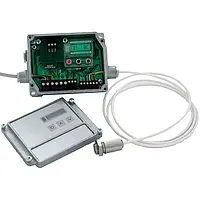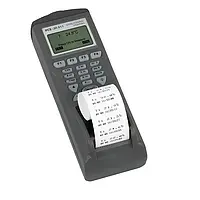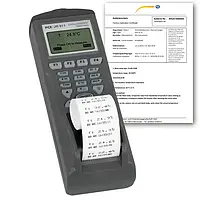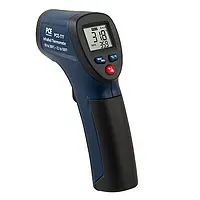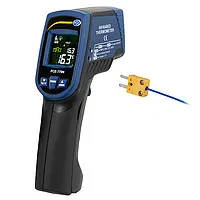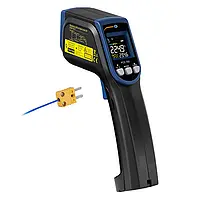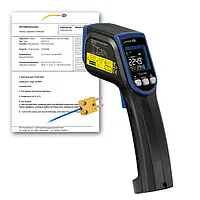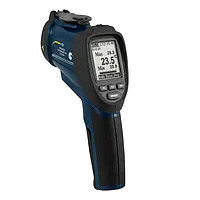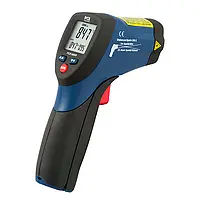Infrared Thermometer with LCD for continuous measurement of surface temperature of all solid materials, designed for fixed installation.
- Temperature range: -40 ... 600 °C / -40 ... 1112 °F
- Accuracy: ± 1% or ± 1°C / 1.8°F
- Optical resolution: 15:1
- Storage conditions: -40 ... 85°C / -40 ... 185°F
- Spectral range: 8.0 ... 14 µm
- Emissivity: 0.100 - 1.000 adjustable in digital mode, by units of 0.001
- Outputs: analogue, USB, RS-232, RS-485, relay
Infrared thermometer for temperatures up to + 500 °C. The measured data can be stored and snet to a computer later on, but the main significant feature of this infrared thermometer is the built-in printer. This makes the test instrument very attractive for use in food applications. As all test equipment, this infrared thermometer is delivered manufacturer calibrated and can additionally be certified to ISO.
With the infrared thermometer you get a measuring device with which you can perform a wide range of measuring tasks. On the one hand, you can directly measure and read the temperature of bodies without contact, on the other hand you can also save the measured values internally in the data logger and transfer them to a PC or laptop via the RS-232 interface.
The infrared thermometer measures the temperature of surfaces non-destructively and from a greater distance using an infrared beam. This lightweight infrared thermometer is characterized by the simplest operation and the red sighting aid.
The Infrared Thermometer PCE-779N measures temperatures quickly and without contact. The infrared thermometer can be used for almost all surfaces. The emissivity of the infrared thermometer is adjustable over the range of 0.1 … 1.0. The infrared thermometer has various measurement functions such as max, min and average measurement.
The Digital Infrared Thermometer PCE-780 consists of an infrared thermometer and an integrated humidity meter. With the two sensors, it can record values to determine the dew point. If this dew point is reached or undershot, there is a risk of moisture settling and thus of mould.
- Infrared measurement range: -76 ... 932°F / -60 ... 500°C
- Infrared temperature measurement
- Air temperature and humidity measurement
- Calculation of dew point
- High contrast LCD display
- Adjustable high and low alarm
The digital infrared thermometer PCE-780A is a dual-function instrument used to measure both temperature and humidity. The dew point, which is calculated by the PCE-780, is displayed on the high-contrast LCD display. The control buttons can be used to set alarm values. If the surface temperatures are exceeded or undercut, the PCE-780 emits a warning tone and displays either a LOW or a HIGH alarm.
- Infrared measurement range: -76 ... 932°F / -60 ... 500°C
- Infrared temperature measurement
- Air temperature and humidity measurement
- Calculation of dew point
- High contrast LCD display
- Adjustable high and low alarm
- Incl. ISO Calibration Certificate
The infrared thermometer is suitable for private and industrial use because of its price-performance ratio. An infrared thermometer is a contactless measuring device. The bright laser dots from infrared instruments are clearly visible and provide easier temperature measurement from a distance.
Infrared thermometers measure temperatures without contact by detecting and evaluating the infrared radiation emitted by the surface to be measured into the environment. This method of measuring radiation has many advantages. The measurement with the IR thermometer is very fast. The measurement results are available within one second, with some device models even after ten microseconds. In addition, with the infrared thermometer there are no measurement errors due to poor thermal contact and there are no signs of wear at contact points. Sensitive objects such as foils, paper, electronic or biological material are neither mechanically nor hygienically affected by the measurements with the IR thermometer.
Infrared thermometers allow safe temperature measurements even on moving measurement objects, live parts and aggressive materials. The measurements can be made continuously, even over long periods and large temperature ranges (e.g. 350 ... 3500 °C). To enable the user to control from which area of the targeted object the sensor picks up the radiation, many IR thermometers are equipped with laser pointers. These are almost always multi-point lasers that indicate not only the centre of the measuring area but also its extent.
The infrared thermometer is usually used to determine the temperature of the nearest visible surface. However, the sensors of the IR thermometers can be designed for different wavelengths so that device models can be optimised for special applications. Often, dangerous or very hot objects are to be measured through glass panes or other protective covers. This is possible if the material of the viewing panes or covers is transparent to the wavelength emitted by the object and this wavelength can be evaluated by the infrared thermometer.
A special feature during the measurement with the IR thermometer is the emission factor. The factor is needed because surfaces not only emit the infrared radiation typical for the object temperature, but can also reflect the incident radiation of other objects. This effect occurs particularly with metallic and shiny surfaces. It is taken into account in the evaluation in the infrared thermometer via the emissivity or emission factor. The majority of IR thermometers are either set to the fixed emissivity of 0.95 or offer the option of adjusting the emissivity for the current measurement. For some applications it is useful to provide the measuring points with measuring point stickers or coatings with known emissivity for repeated measurements
Objects and substances that surround us radiate energy into the environment. This applies not only to objects where we can feel the heat radiation, such as the sun, a radiator or a freshly brewed coffee, but also to any substance that is warmer than zero Kelvin – i.e. minus 273.15 degrees Celsius. The amount of energy emitted increases in proportion to the fourth power of the current temperature of the object. This knowledge forms the basis for an infrared temperature measurement.
The infrared thermometers have a wide range of applications. 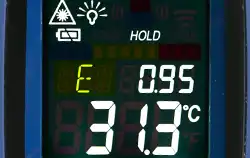
With the emission factor, however, a variable occurs that complicates the evaluation of the measurement results for some surfaces. The emission factor is defined as the measure of the ratio of the radiations emitted by a grey body and a black body at the same temperature. Some infrared thermometers only give temperatures for the fixed emission factor of 0.95, but many models offer the option of selecting the emission value via the device menu.
The infrared thermometer always measures the surface temperature. For various reasons, this temperature on the surface can be significantly lower, but also higher than the temperature in deeper layers of the object. In addition, reflections and mirroring can occur on highly polished surfaces, which falsify the measurement results.
The infrared thermometers are suitable for a wide variety of applications due to their contactless and fast measurement, where the requirements sometimes differ greatly. For example, surface temperatures are determined on buildings, but also on living beings, on stationary or moving machine parts and on products and materials in the production process.
Also the measurements from a greater distance or on corrosive or very hot materials are also no problem if the infrared thermometer used has the appropriate specifications. The following sections discuss the following important features that should be considered when selecting a device:
- Mobile or stationary use
- Measuring range
- Accuracy
- Measuring rate/response time
- Emissivity
- Spot ratio
- Sighting aid
- Measurement memory and interfaces
- Additional sensors
- Evaluation functions
Mobile or stationary measurement
The infrared thermometers for stationary measurements are fixed for a longer period of time to control a measuring point and continuously determine the temperature there. They often transmit the values analogue or digitally to a process control system or a controller and are supplied with the necessary operating voltage via a cable. Mobile infrared thermometers are location-independent due to batteries. In contrast to the stationary models, the mobile ones almost always have an aiming aid and a digital display for the measured temperature.
Measuring range and accuracy
Each infrared thermometer is designed to measure a specific temperature range. For example, many models are available with measuring ranges from -30 °C to 500 °C, the others cover a temperature range from - 50 °C to 1,850 °C. Within the respective measuring range, there are usually sub-ranges with different accuracy. When comparing different models, it is important to ensure that the accuracy is sufficient for the temperature range relevant to the intended application.
Measuring rate or response time
A high measuring rate or a short response time of the infrared thermometers is particularly important when measuring the objects that move out of the field of view or when temperature changes are to be recorded very detailed. If the sensor's measuring rate is high, it must be ensured that the transmission and storage rate is also correspondingly high. Response times of 150 milliseconds are now standard for many types of device.
Fixed or selectable emissivity
When measuring temperature with the infrared thermometer, it is important to take into account that the measured value is influenced by the properties of the material and surface of the measured object. This can be compensated for by one factor – the emissivity or emission factor. The infrared thermometers where the emissivity cannot be adjusted are set either to the factor 0.95 or to the factor for the specific application. The instrument models with adjustable emissivity usually offer the possibility of setting the values between 0.1 and 1.0 or 0.3 and 1.0. If the correct factor is not known, it can usually be determined by comparative measurements or taken from tables.
Spot ratio
Every infrared thermometer has an optical system with a certain spot ratio. This indicates the distance the optics of the device must be from the measuring point in order to achieve a certain size of the measuring spot. The first number stands for the distance and the second number for the diameter of the measuring spot. A spot ratio of 8:1 means that at a distance of eight centimetres the spot has a diameter of one centimetre. For the measurements of very small parts or measurements from a great distance, there are infrared thermometers with a spot ratio of 50:1, 60:1 but also with 120:1 or even 300:1. Only a few special models offer the possibility to reduce or enlarge the spot at the same distance.
Sighting aid
Infrared radiation is not visible. Sighting aids are available to ensure that the surface temperature is measured at the correct spot. Almost all mobile infrared thermometers offer visible laser markings for this purpose. The simplest form is a simple laser dot. Better is a cross laser with two visible points. The two points change their distance to each other when the distance of the thermometer to the measuring point is changed. The distance between the laser points indicates the size of the measuring spot. Circular lasers, as sighting aids, show even more clearly the size of the measuring spot on the surface of the object. The infrared thermometers with a very large measuring spot ratio also have additional control devices such as a telescopic sight and can be mounted on tripods.
Memory and interfaces
Some infrared thermometers offer the possibility to store the measured values in an internal memory or to send them to mobile devices via Bluetooth. The values stored in the device can usually be transferred directly to a computer in electronic form. The data interface is often a USB interface or the data is stored directly on an SD memory card. The infrared thermometers for fixed installation often have analogue or switching interfaces with which the processes can be controlled.
Additional sensors
For some applications, it is useful to have additional sensors built into the device. For example, the infrared thermometers are often used that also have a connection for type K thermocouples for the contact temperature measurement. Also the models with additional sensors for measuring air temperature and humidity also offer clear advantages over the use of several devices in some applications.
Evaluation functions
The infrared thermometers can not only measure but, if they are equipped with appropriate functions, they can also compare the measured value with the predefined or freely selected limit values. If the measured value exceeds or falls below these limits, optical or acoustic alarms or switching interfaces are triggered. Maximum temperatures, minimum temperatures and average values can also be determined and immediately displayed.
Calibration is a technical term for checking the measuring accuracy of measuring instruments and measuring aids. Thermometers have different measuring accuracies due to their design. Therefore, the accuracy for each thermometer is stated in the technical specifications. The accuracy may be given as an absolute value in degrees Celsius, degrees Fahrenheit or Kelvin, as a relative value as a percentage of the measured value or as a combination of both, for example ±0.2 °C, ±0.3 % of the measured value or ± (0.4 % + 1 °C). If the accuracy is specified as 0.15 °C or 0.2 % of the measured value, the higher value always applies.
However, due to various influences on the thermometer, especially on the components involved in the measurement, the specified measurement error may be exceeded. Therefore, the accuracy of the thermometer should be checked. Depending on the demands on accuracy and the type of the instrument to be tested, different calibration procedures can be used for the thermometers. To ensure that the results of the calibrations are traceable, comparable and independent of the user, the procedures and conditions for each method must be clearly defined.
In general, calibrations for thermometers can be differentiated into:
- Calibrations with the aid of tested reference thermometers,
- Calibrations for contact thermometers with the aid of substance mixtures in which a known temperature is established,
- Calibration for radiation thermometers with the aid of heatable blackbody radiators or cavity radiators.
Reference thermometers for comparison measurements
Many thermometers are calibrated against a reference thermometer. In order to measure correctly, this reference or standard thermometer should have been calibrated directly or indirectly via other reference thermometers, at the fixed points of the ITS-90 scale. Calibration certificates shall be issued to prove the calibrations. During the comparison measurement, it must be ensured that the thermometer to be tested and the reference thermometer assume the same temperature in the intended temperature range. For this purpose, both thermometers can be placed in temperature baths or climatic chambers, for example.
Temperature scale ITS 90
The internationally recognised ITS 90 temperature scale specifies various reproducible fixed points between -260 °C and 1085 °C, which facilitate the practical determination of temperatures. The melting or triple points of water and certain chemical elements serve as reference points. At the triple point or three-phase point of a substance, the three aggregate states solid, liquid and gaseous are in equilibrium. In other words, they do not change the existing quantitative ratio. Water molecules, for example, have their triple point at 0.01 °C and 6.12 mbar. If the temperature or pressure is changed, the proportions of the three phases shift.
Temperature fixed points, calibration baths, calibration ovens, block calibrators
Special temperature measuring cells, calibration baths and calibration ovens have been developed for applications in which thermometers have to be calibrated with the highest precision. When used correctly, these special devices enable constant and reproducible temperature reference points to be maintained. However, the expense of purchasing and operating these devices is only justified if they are used frequently. Many companies and research institutions therefore commission external calibration laboratories to calibrate their thermometers.
Calibrating infrared thermometers with temperature radiators
Temperature emitters with high emissivity are used to calibrate radiation thermometers. The measuring range and the accuracy of the infrared thermometers to be tested determine decisively which blackbody radiator can be used. True cavity radiators are shaped so that no deviations occur due to draughts or reflections. There are also independently heatable temperature radiators for high and very high temperatures and cavity radiators as attachments for water-guided calibration thermostats, with which a very high temperature accuracy and stability can be achieved.
Determining the reference points for calibration
Before a thermometer is calibrated, the desired temperature range and the number and position of the reference points must be determined. The temperature range should be limited as far as possible to the temperatures that the thermometer is to be used to check. In this way, the effort for calibration can be reduced. At least three to five reference points should be selected for the chosen temperature range. The test temperatures should cover the complete range in such a way that conclusions can be drawn about the distribution of measurement errors. If the thermometers are sent to the external calibration laboratories for calibration, the desired reference points should be clarified beforehand. Otherwise, the laboratory will use the reference temperatures determined by itself, which may be completely uninteresting for the application.
The infrared thermometers can be calibrated according to the specified rules. If the results and conditions of the tests carried out are certified by an ISO calibration certificate or DAkkS calibration certificate, the device is certified. This certifies that the accuracy of the equipment is traceable to the national standards. In addition to the device and test data, the certificates also contain the date of the calibration and, of course, details of the person responsible and their qualifications.
Many users would like to include the certified infrared thermometers in their internal ISO test equipment pool and would like to be able to clearly assign the certificate to their company. For this reason, the calibration certificate is only issued for many new infrared thermometers when there is a corresponding order. This procedure not only has the advantage that the calibration and certificate are very up-to-date, but the user can also influence for how many and which reference temperatures the measurement accuracy is checked. The name and address data of the client are indicated in the certificate.
Since the accuracy of the measuring instruments can deteriorate due to various influences, calibration intervals are often specified. The important points to consider when determining the interval between two calibrations include:
- the measurement stability and susceptibility to interference of the sensor
- the permissible deviation
- the effects of measurement errors
- the operating conditions
Since only the first point is instrument-dependent and the others are determined by the application, it is usually the responsibility of the user to determine and monitor the correct calibration interval for the test equipment.
What influence do the wavelengths NIR, MIR, FIR have on the infrared thermometer?
Infrared radiation can be further subdivided into
| • NIR | -> | Near Infrared | 0.780 µm to 1.400 µm |
| • MIR | -> | Mid-infrared and | 1.400 µm to 3.000 µm |
| • FIR | -> | Far Infrared | 3.000 µm to 1 mm |
Which measuring wavelength is ideal for a temperature determination with the infrared thermometer depends on the respective material and the temperature range. 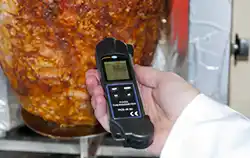
Can the infrared thermometer measure through glass?
With the IR thermometer that detects the infrared radiation in the range of 8 ... 14 µm, it is not possible to measure the infrared radiation from the objects that are located behind the panes of glass. However, when the temperature of the heated or glowing materials is to be measured in an oven without contact, an infrared viewing window can be installed in the oven door or in the wall of the oven housing. This viewing window is made of a material that is permeable to certain wavelengths of IR radiation.
Industrial applications
Stationary infrared thermometers enable continuous temperature monitoring both for process automation and in test procedures for quality assurance or troubleshooting. The use of digital technology allows not only automated processes, but also remote temperature controls and evaluations. Depending on the application, miniature measuring heads or sophisticated IR thermal cameras are used for this purpose. The measured data are immediately transmitted further via suitable interfaces.
The infrared thermometers in industry are reliable and cost-effective solutions for temperature measurement that enable fast, accurate and reliable determination of the temperature in thermal processes in industrial manufacturing, testing, cleaning or drying. By reducing waste and rework and optimising energy use, effectiveness and productivity increase.
Applications in steel production and processing
In the steel production, the infrared thermometers can be used at every stage of production to monitor temperature. They increase work safety and simplify the data recording. The precise temperature measurements continuously indicate with high accuracy whether the thermal processes are running as intended. In many production steps, it is possible to intervene in the event of deviations so that the steel obtains the specified metallurgical properties with a justifiable energy consupmtion. The use of the infrared thermometers guarantees simple monitoring and control of the desired temperatures. This means that the required product quality can often be achieved with less energy input.
Industrial maintenance and servicing
During the maintenance of machinery and equipment, excessive heating is often a sign of wear or misalignment of components. If ignored this can lead to scrap being produced, equipment being damaged or even people being injured. Therefore, temperature measurements are part of many inspections. With the infrared thermometer, measurements can easily be taken even on moving parts of running machines.
Mobile infrared thermometers are usually used for routine inspections that are carried out on a regular basis. If potential or acute problems are detected, corrections can be made or repairs scheduled during the operation before shutdowns are necessary. Permanently installed types of devices, on the other hand, are used when the temperature on a machine needs to be constantly monitored in order to cool or throttle the performance if necessary.
Maintenance on domestic installations and thermal inspection of buildings
The infrared thermometers and infrared cameras can be used for non-destructive testing of air conditioning systems, boilers and electrical systems and on all types of building structures to detect temperature differences. Excessive heating or lack of heat on technical components that are supposed to transfer heat are always indications that should be inspected to prevent major damage or failures.
Not only the thermal bridges and areas at risk of condensation can be identified on building structures by examining them with the infrared thermometer. With the thermal imaging cameras it is also possible, with sufficient temperature gradient, to quickly visualise the position of concealed structural elements and supply lines without touching the surface.
The measurement of temperatures of glass or on different types of glass brings some difficulties, because of the reflection and transmission of the glass. To limit the problems which may arise during the application of the infrared thermometer, there are several ways to carry out the temperature measurement.
The first way to measure the temperature with a pyrometer is to use an infrared thermometer, which is in the wavelength range of 1.0 microns, 2.3 microns or 3.9 microns. However, these wavelengths make it possible to measure not directly the surface temperature, but just below the glass surface. Wavelengths of the IR thermometers with 5 μm and 7.9 μm ensure that also the surface is measured. A disadvantage of these wavelength ranges is that the temperature of the glass must be very high. It is therefore not suitable for the temperature measurements in the lower measuring range.
A second option for measuring the temperature of glass is to use a thermometer with a wavelength of 8 ... 14 microns. In this case, however, there is a difficulty that the reflection of the surface must be compensated by the thermometer. Often, this can be done only by very expensive pyrometers. It is also important to remember that the degree of emissivity should be set to 0.85 and that the infrared thermometer should have a fast response time, because glass can change the temperature quickly due to the poor thermal properties.
In order to be able to measure the surface temperature still quickly and easily with an infrared thermometer with a wavelength of 8 ... 14 μm, so-called emission grade stickers can be applied. These stickers have a degree of emissivity of 0.95. They are simply glued to the glass. After a while, the sticker gets the temperature of the glass and the surface temperature can be measured with any standard infrared laser thermometer. Practically, the temperature of the glass is measured then. This is a fast, easy and inexpensive method to measure the glass temperature in a contactless way.
For most organic – i.e. carbon-containing – materials, the temperature can be determined with sufficient accuracy by measuring the infrared radiation if the emissivity is set to 0.95. This is why the infrared thermometers that cannot be set to 0.95 have this factor stored. For this reason, the infrared thermometers for which the emissivity cannot be set have this factor stored. For transparent and shiny objects that transmit or reflect the infrared radiation of other objects, the emissivity factor must be adjusted to obtain correct results.
For many materials with deviating emission values, examples have been published in tables. For example, for copper there are the following values: 0.012 (polished at 327 °C), 0.78 (strongly oxidised at 25 °C), 0.91 (strongly oxidised at 527 °C). When adopting such values, it should be noted that they always depend on the surface condition of the object and usually also on the wavelength that is measured. Often the emissivity also changes with the temperature.
Other factors that influence the emissivity are the roughness of the surface, e.g. polished, ground, oxidised, sandblasted, and the measuring angle. In connection with the measuring angle, the surface geometry of the object to be measured must also be taken into account. Whether the surface is flat, curved inwards or outwards or structured has an influence on how many infrared rays reach the detector in the infrared thermometer.
Because of the many influencing factors, the correct emissivity must be determined in advance by comparative measurements In the cases where an exact measurement result is required. For this purpose, a suitable material sample should be heated and tested at different measuring points in the required temperature range. For the comparison measurements, the infrared thermometer should be used that is also to be used for the later measurements, so that it is certain that the measuring wavelength is the same.
Comparative measurements with a contact probe
Many infrared thermometers are also equipped with a connection for thermocouples or resistance temperature probes for contact measurement. Often these offer the same or an even larger measuring range. This means that the complete measuring range of the infrared sensor can be easily checked by means of the contact measurements. If the comparison values differ, the emissivity is adjusted until the measured values match. Using this method, specific values for the respective emissivity can be determined for certain workpieces at different temperatures and processing conditions.
Comparative measurements with sticker or paint application
For the comparative measurements, the reflective surfaces can also be covered with a suitable thin adhesive tape or sticker with a known emissivity, or coated with a matt varnish the emissivity of which is known. When the cover has assumed the temperature of the object, the measurements are made with the same infrared thermometer on coated and uncoated areas of the object. If necessary, the emission value for the uncoated area is then adjusted until the temperature reading corresponds to that of the coated area.
It is commonly known that many foods do not spoil as quickly if they are stored at certain temperatures or if they are made more durable with the help of a suitable process. There are a number of regulations for the food industry in this regard. Anyone who processes food or trades in food is obliged, among other things, to create an HACCP concept tailored to the conditions in the company. HACCP stands for Hazard Analysis and Critical Control Points.
Many HACCP concepts define time points and places where temperatures are to be monitored randomly, regularly or continuously. In addition to the reliable temperature determination, it is also important that the food is not contaminated because of the contact with the measuring device. For this reason, infrared thermometers are often used for the measurements on the food. These can determine the surface temperature of the material without touching it. Where it is necessary to determine the core temperature, also the contact thermometers with easy-to-clean penetration probes are also used.
For many foods, exact temperature sequences must be maintained during cooking or preservation in order to achieve the desired product properties. 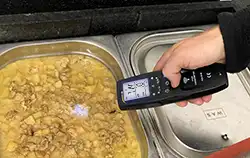
So that the foodstuffs last for a long time but lose as few vitamins and flavours as possible as a result of the temperature treatment, the specified temperatures must be maintained as accurately as possible over the intended period of time. The infrared thermometers used during the industrial food processing usually transmit the measured values directly as an analogue or switching signal. This means that heat can be added or dissipated immediately if the measured values exceed or fall below the defined limit values.
In addition, the signals transmitted by the infrared thermometer can be used to record the temperature curves during the entire process. This enables the detailed evaluations to be made in the event of both deliberate and unintentional changes of the output parameters. For example, the product batches that have not been heated sufficiently can be sorted out immediately and retreated or used in a different way.
The examples of the temperature-dependent preservation methods in the food industry that can be easily monitored with the infrared thermometer are drying, pasteurisation and sterilisation. In the drying, which is only suitable for certain foods, the removal of water ensures a longer shelf life. The drying process can be accelerated by selectively adding heat. However, to ensure that only the water is released, the temperature during drying must be limited and good ventilation must also be ensured.
In the pasteurisation, food is heated to less than 100 degrees Celsius for only a short time to kill heat-sensitive undesirable yeasts and moulds. The sterilisation, on the other hand, involves heating to at least 110 degrees Celsius for a longer period of time, which renders other microorganisms harmless. Heat sterilisation is also used to render cleaned tools germ-free.
It is also important to ensure that the correct temperatures are maintained when transporting and storing perishable food. Especially in the case of chilled and frozen goods, each consignment must be checked for temperature and visual abnormalities upon delivery. For some transports, temperature data loggers are placed with the refrigerated goods in order to record the temperatures without interruption.
It is common knowledge that many foods have a limited shelf life and that the length of the shelf life is strongly influenced by the ambient climate. Anyone who processes food and places it on the market must ensure that consumers are not endangered by the offered products. Operators of restaurants, canteens, fast-food restaurants, snack bars and other catering establishments are obliged to set up and comply with hygiene concepts. In addition to protection against contamination, the important contents of these hygiene concepts always include controlling the temperature of the foodstuffs.
Goods receipt in catering establishments
Foodstuffs that are delivered already cooled or for which cooling is prescribed or intended are already checked for visible impairments upon delivery. In addition, the temperature of the goods is measured at relevant points. With a suitable mobile infrared thermometer, the temperature on the surface can be determined quickly and without contact at various points. The infrared thermometers for the catering industry usually have an additional stable stainless steel probe that can also be used to measure core temperatures. The insertion probe, which is carefully cleaned after each measurement, is inserted into the delivered material at specified points. The temperature differences determined in this way can provide information about the temperatures during transport and previous storage.
Foodstuffs storage
Foodstuffs are usually stored in separate storage rooms for shorter or longer periods of time. Depending on the type, size and equipment of the rooms, different temperature levels can occur there. With the infrared thermometer, the temperature of the stored food can be measured quickly and without contact at any time. If necessary, the storage place or possibly the room temperature can be changed. In addition, the temperatures determined by the infrared thermometer can be used to determine the right time to remove the food. Many foodstuffs should be brought slowly to room temperature before processing.
Food preparation
Infrared thermometers can also be used for temperature control during food preparation. For example, you can quickly measure how hot a grill surface or the contents of a pot are. Regardless of whether the food is chilled, frozen or cooked, the infrared thermometers measure its current temperature contact-free and hygienically. Some models of the infrared thermometers for the catering sector also immediately display a warning if cooling temperatures are exceeded or if warm food has cooled down too much. These devices are particularly recommended for checking the temperatures at cold and hot buffets.
Body temperatures can provide information about physical activity and the state of health. Not for nothing is it said that athletes should warm up slowly before high loads. During both power and endurance sports, but also during strenuous physical work, the body temperature rises due to muscular activity. On the other hand, the immune system also reacts to infections by raising the temperature. Elevated core body temperatures above 38 ° C in the case of individuals without physical exercising are referred to as fever. Persons diagnosed with fever should rest as much as possible and be isolated from the others.
The accurate measurement of the body temperature is usually performed with a clinical thermometer approved for this purpose. A significant advantage of the devices with infrared measurement is their speed. The measured body temperature can be read almost immediately. In the case of dangerous infectious diseases, the symptoms of which include fever, persons can be easily checked for the elevated body temperature with infrared cameras as they pass by. Suspicious persons can then be quickly separated and examined more closely. Such checks, for example at airports, can slow down the spread of highly contagious diseases.
IR thermometers with medical approval
Fever thermometers with approval as medical devices are available in various versions. While contact thermometers measure under the tongue, under the arm or rectally, the infrared thermometers measure the temperature on the forehead or in the ear. The measuring range, optics and emissivity of these infrared thermometers are designed to measure the body temperature. Nevertheless, it must be taken into account that the measurement result can be influenced by many factors.
In the analogue glass thermometers, the measured temperature can be read on a scale. These clinical thermometers do not require any auxiliary energy and as a rule can usually be sterilized without any problems. Digital contact thermometers and infrared thermometers require batteries to determine and display the reading. With some of the digital contact thermometers and infrared thermometers it is possible to store the measurement values and to signal about abnormal values immediately by optical or acoustic alarms.
Infrared thermal images in medical diagnostics
Infrared thermometers can be used for more than just quick fever measurement. Special devices with thermal imaging show the heat distribution of the specific body regions. This makes it possible, for example, to visualize the location and spread of inflammations without affecting the body with radiation. 
IR thermometers without medical approval
For the quick control of individuals or groups of people for increased body temperature, the infrared cameras or infrared thermometers can also be used, which do not have approval as a medical device. These measurements are made without body contact. When selecting the infrared thermometers, care must be taken to ensure that the accuracy in the critical measurement range is high and that the measurement spot ratio is suitable for the intended measurements on the forehead. When evaluating the measurement results, it must be taken into account that the forehead temperature is usually lower than the core body temperature. In addition, hair, sweat, creams and makeup can influence the measurement of the infrared radiation. Besides, it must generally be considered that the body temperature can increase because of meals or physical exercising.
IR thermometers in veterinary medicine Infrared thermometers and thermal imaging cameras are also very appropriate for the application in the veterinary medicine. The small and lightweight devices can be easily transported and used in the environment the animal is accustomed to. The measurement itself is fast, painless and contact-free and causes no additional stress. Unlike mobile X-ray devices, the infrared thermometers do not emit any radiation. A helper can therefore calm the animal during the measurement, hold it or bring it into the desired position.
